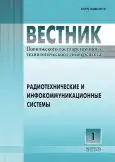Analysis of Algorithms for Implementing Self-Diagnostic Procedures in Analog-to-Digital Converters Using Neural Networks
- Авторлар: Naborshikov A.A.1, Posyagin A.I.1, Yuzhakov A.A.1
-
Мекемелер:
- Perm National Research Polytechnic University
- Шығарылым: № 1 (2024)
- Беттер: 35-46
- Бөлім: Computer engineering and informatics
- URL: https://bakhtiniada.ru/2306-2819/article/view/275994
- DOI: https://doi.org/10.25686/2306-2819.2024.1.35
- EDN: https://elibrary.ru/KZCIGW
- ID: 275994
Дәйексөз келтіру
Толық мәтін
Аннотация
Introduction. In modern digital control systems, ensuring the reliability of ADCs is topical. Self-diagnosis algorithms are commonly employed to detect and address failures, thereby enhancing reliability. This research aims at developing a novel approach by harnessing the capabilities of a local fragmented control device (LFCD) to identify failures in the main measuring neuron (MMN) system, followed by the exclusion of the failed MMN from the neural network.
Materials and Methods. The study applied self-diagnosis algorithms to identify failed MMNs for two neural network structures: the "Internal Feedback Structure" and the "Redundant Link Structure." Graphical interpretations of the operation sequence are provided for cases of complete uncertainty, where the state of all neurons from the base group is unknown, and for cases of the unknown state of one neuron. The concept of the base group is introduced as the minimum number of neurons required for self-diagnosis.
Results and Conclusion. In the MatLab Simulink environment, we developed a model to compare neural network structures and self-diagnosis algorithms. We utilized this model to investigate the algorithm complexity and total time required for neural network analysis based on the number of tested neurons. Our findings demonstrated that for the "Internal Feedback Structure," the base group consists of 2m MMNs, where m represents the ADC resolution during self-diagnosis, while for the "Redundant Link Structure," it is 2m+1. The analysis highlighted that the "Redundant Link Structure" and selecting parameter m=3 represent the most optimal solution, offering shorter verification time and requiring less hardware resources while maintaining other characteristics.
Practical Significance. Research findings will enable subsequent self-diagnosis of control system elements and developing a diagnostic algorithm that ensures parallel checking in different areas of neural networks and the process of analog-to-digital conversion on the free part.
Толық мәтін
Авторлар туралы
Anton Naborshikov
Perm National Research Polytechnic University
Хат алмасуға жауапты Автор.
Email: anton.naborshikov@gmail.com
ORCID iD: 0000-0002-8386-7376
SPIN-код: 5585-1141
PhD student at the Department of Automation and Telemechanics
Ресей, 29, Komsomolsky avenue, Perm, 614013Anton Posyagin
Perm National Research Polytechnic University
Email: anton.naborshikov@gmail.com
SPIN-код: 4544-9816
Candidate of Engineering Sciences, Associate Professor at the Department of Automation and Telemechanics
Ресей, 29, Komsomolsky avenue, Perm, 614013Alexander Yuzhakov
Perm National Research Polytechnic University
Email: anton.naborshikov@gmail.com
ORCID iD: 0000-0003-1865-2448
SPIN-код: 4820-8360
Doctor of Engineering Sciences, Professor, Head of the Department of Automation and Telemechanic
Ресей, 29, Komsomolsky avenue, Perm, 614013Әдебиет тізімі
- Liu G, LiG, Peng Z, Pan H. Adaptive neural network dynamic surface control algorithm for pneumatic servosystem. Proceedings of the 11th International Conference on Modelling, Identification and Control (ICMIC2019). Lecture Notes in Electrical Engineering. Tianjin, China; 2019:821-829.
- Daponte P, De Vito L, Mazzilli G. et al. Metrology for drone and drone for metrology: Measurement systems on small civilian drones. 2015 IEEE Metrology for Aerospace (MetroAeroSpace). 2015:306-311.
- Tetenkin YuG. Analog-digital converter for embedded systems with correction of nonlinearity of sensing devices (sensors). Vestnik of Volzhsky University named after V.N. Tatischev. 2011;(17);72-77. (In Russ.).
- Baidarov AA. Adaptive measuring converter of parameters of harmonious signals as diagnostics and analysis means. Information-measuring and Control Systems. 2010;8(12);112-115. (In Russ.).
- Posyagin AI, Yuzhakov AA. Development of an analog-to-digital converter based on a neural network. Jelektrotehnika. 2012;(11);18-24. (In Russ.).
- Glinkin EI, Glinkin ME. Technology of analog-to-digital converters. Tambov, Tambov State Technical University; 2008. 140 p. (In Russ.).
- Walt Kester. The Data Conversion Hand-book. Elsevier/Newnes; 2005. 953 р.
- Rudy J. van de Plassche. CMOS Integrated Analog-to-Digital and Digital-to-Analog Converters. The Springer International Series in Engineering and Computer Science. 2nd ed; 2003. 583 р.
- Kalchenko SB, Melnikov VA, Kharchenko VS. Dynamic architecture and modular computing systems for LIC. Zarubezhnaja radiojelektronika. 1990;(1);63-84. (In Russ.).
- Sandberg S. Homing and Synchronizing Se-quences. Model-Based Testing of Reactive Systems, Ser. LNCS. Springer. 2005;3472:5–33.
- Spirina EA, Chabdarov ShM. Distribution of information flows in systems operating in the information field. Vestnik of Volga State University of Technology. Series “Radio Engineering and Infocommunication Systems”. 2019;(4);6-15. (In Russ.)
- Makagonov NG, Posyagin AI, Yuzhakov AA. Principles of self-routing of signals in an analog-to-digital converter based on a single-layer neural network. Jelektrotehnika. 2016;(11);3-6. (In Russ.).
- Vasbieva AF, Oniskiv LM, Posjagin AI et al. Structure of the main measuring neuron in a self-routing analog-to-digital converter. Information-measuring and Control Systems. 2015;13(9);3-8. (In Russ.).
- Artemev IA, Posjagin AI, Cygancev VA. Development of the main measuring neuron based on the STM8 microcontroller for a self-routing analog-to-digital converter. Proceedings of Russian scientific and technical conference Automated control systems and Information technologies, June,2022. Perm: Perm National Research Polytechnic University; 2022:19-25. (In Russ.).
- Pasquale Daponte, Linus Michaeli. ADC & DAC modelling and testing. Measurement. 2007. Vol.,40, Iss. 5. Pp. 459-462.
- Naborshchikov AA, Yuzhakov AA, Posyagin AI. Possible Approaches to Organizing Self-Test of a Self-Routing Analog-To-Digital Converter Based on a Neural Network. Proceedings of the 2022 Conference of Russian Young Researchers in Electri-cal and Electronic Engineering, ElConRus 2022, St. Petersburg; 2022:391–394.
- Smirnov DN. Analysis of neuron AD conversion in golden ratio codes. Electrosvyaz Magazine. 2007;(8);20-22. (In Russ.).
- Chelebaev SV, Melnik OV, Chelebaeva YA. Application of simulation modeling for the analysis of neurons of converters of time-and-frequency parameters of signals in a digital code. 2018 7th Mediterranean Conference on Embedded Computing, MECO 2018 – Including ECYPS 2018, Proceedings: 7, Budva. Budva; 2018:1-4.
- Katsko EV, Posyagin AI, Yuzhakov AA. An autocontrol system based on neurons in a self-routing analogue converter. Russian Electrical Engineering. 2014;85(11):703-707.
- Kleiman LA, Kon EL, Freiman VI et al. Improving the Reliability of Information Control System Elements Using Embedded Diagnostic Tools. Vestnik of Volga State University of Technology. Series “Radio Engineering and Infocommunication Systems”. 2019;(3);29-40. (In Russ.).
Қосымша файлдар















